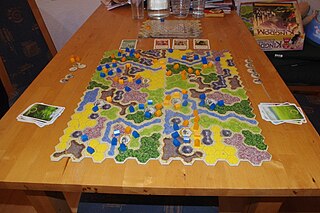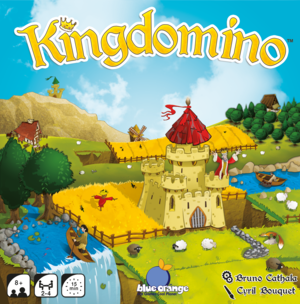
Elfenland is a German-style board game designed by Alan R. Moon and published by Amigo Spiele in German and Rio Grande Games in English in 1998. Elfenland won the Spiel des Jahres award in 1998.

Carcassonne is a tile-based German-style board game for two to five players, designed by Klaus-Jürgen Wrede and published in 2000 by Hans im Glück in German and by Rio Grande Games and Z-Man Games (currently) in English. It received the Spiel des Jahres and the Deutscher Spiele Preis awards in 2001.

Alhambra is a 2003 tile-based German-style board game designed by Dirk Henn. It was originally published in Germany by Queen Games in a language-interdependent version; an English-specific version was released in North America by the now-defunct Überplay. The game is an Arabian-themed update, set during the construction of the Alhambra palace in 14th century Granada, of the 1998 stock trading board game Stimmt So!, which in turn was an update of the 1992 mafia influence board game Al Capone; the original version was subsequently released as Alhambra: The Card Game. Upon its release, Alhambra won numerous awards, including the Spiel des Jahres award. Its success has led to the release of numerous expansion packs and spin-off games, and is becoming Queen Games' flagship franchise.

Rummikub is a tile-based game for 2 to 4 players, combining elements of the card game rummy and mahjong. There are 106 tiles in the game, including 104 numbered tiles and two jokers. Players have 14 or 16 tiles initially and take turns putting down tiles from their racks into sets of at least three, drawing a tile if they cannot play. In the Sabra version, the first player to use all their tiles scores a positive score based on the total of the other players' hands, while the losers get negative scores. An important feature of the game is that players can work with the tiles that have already been played.
Mozaic is a two-player abstract strategy board game in which players try to score points by placing colored glass gemstones onto a game board to form square patterns. The game was designed by Martin H. Samuel. Originally produced by Games Above Board, Sunnywood, Inc., of Hong Kong, then licensed the game and published it through Sterling Games in 2003. Giseh Verlag launched the game in Germany at Essen Spiel in 2006. An Axiom-powered electronic version of Mozaic was programmed for the PC platform by Greg Schmidt in 2010.

Tsuro is a tile-based board game designed by Tom McMurchie, originally published by WizKids and now published by Calliope Games.

Drunter und Drüber is a multiplayer board game invented by Klaus Teuber, first published in 1991 in Germany by Hans im Glück. A second edition was released in 1994 by Hans im Glück and featured art by Franz Vohwinkel. The game was repackaged and rethemed as the western game Wacky Wacky West in 2010.
Ta Yü is an abstract strategy game based on the legendary Yu the Great.
Manhattan is a board game designed by Andreas Seyfarth. In the game, players aim to construct and control skyscrapers that will award points. Manhattan received generally positive reviews and won the 1994 Spiel des Jahres award.
6 nimmt! / Take 6! is a card game for 2–10 players designed by Wolfgang Kramer in 1994 and published by Amigo Spiele. The French version is distributed by Gigamic. This game received the Deutscher Spiele Preis award in 1994.

Qwirkle is a tile-based game for two to four players, designed by Susan McKinley Ross and published by MindWare. Qwirkle shares some characteristics with the games Rummikub and Scrabble. It is distributed in Canada by game and puzzle company Outset Media. Qwirkle is considered by MindWare to be its most awarded game of all time. In 2011, Qwirkle won the Spiel des Jahres, widely considered the most prestigious award in the board and card game industry. A sequel, Qwirkle Cubes, was released by Mindware in 2009.
Café International is a 1989 tile-laying board game created by Rudi Hoffmann that won the Spiel des Jahres in 1989.

Kingdom Builder is a strategy board game designed by Donald X. Vaccarino, published in 2011 by Queen Games with illustrations by Oliver Schlemmer in German, British and international versions.

Las Vegas is a board game designed by Rüdiger Dorn and published by Ravensburger in 2012. It is named after the city of Las Vegas in Nevada, United States and has a gambling theme. The game was also nominated for the Spiel des Jahres prize in 2012.

Splendor is a multiplayer card-based board game, designed by Marc André and illustrated by Pascal Quidault. It was published in 2014 by Space Cowboys, Asmodee. Players are gem merchants of the Renaissance, developing gem mines, transportation, and shops to accumulate prestige points. Splendor received positive reviews and received numerous awards, including winner of Golden Geek Best Family Board Game, and nominated for the Spiel des Jahres Game of the Year in 2014. The game also received a mobile application and an expansion released in 2017.

Kingdomino is a 2016 tile board game for 2-4 players designed by Bruno Cathala and published by Blue Orange Games. In this 15-20 minute, family-oriented game, players build a five by five kingdom of oversized domino-like tiles, making sure as they place each tile that one of its sides connects to a matching terrain type already in play. The game was critically successful and won the 2017 Spiel des Jahres award, and was followed by several spin-offs and expansions.
Karuba is a tile-laying race game for 2–4 players, designed by Rudiger Dorn and published by HABA in 2015. Each player has 4 explorers, which move through the jungle on the player's private board in order to discover treasure and reach hidden temples. The game was nominated for the 2016 Spiel Des Jahres award.

Metro is a board game by Dirk Henn, for 2 to 6 players.
Dragomino is a children's tile-laying board game designed by Bruno Cathala, Marie Fort, and Wilfried Fort and published by Blue Orange Games. It is based on Kingdomino.

Cascadia is a 2021 board game designed by Randy Flynn and published by Flatout Games. In Cascadia, player draft and add habitat tokens and matching wildlife tokens to score victory points based on various scoring conditions. Upon its release, Cascadia received critical success, with reviewers praising its components, accessibility, and strategy, but also noting its lack of player interaction. Cascadia won the 2022 Spiel des Jahres.












